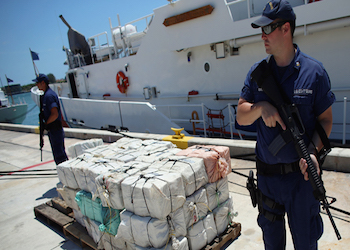A new US engagement plan for the Caribbean is a sign that the major drug-consuming nation has started to plug a hole in its security and drug trafficking prevention strategies in the region.
On June 21, the United States unveiled a new aid program, “Caribbean 2020: A Multi-Year Strategy To Increase the Security, Prosperity, and Well-Being of the People of the United States and the Caribbean,” to a region in the Americas that has increased in importance as a drug trafficking hub and transhipment point in recent years.
The strategy establishes the priorities of the State Department and US Agency for International Development (USAID) “in the areas of security, diplomacy, prosperity, energy, education, and health.”
Regarding security, the plan is to work to “dismantle illicit trafficking networks, enhance maritime security, confront violent and organized crime, and increase the sharing of threat information among countries,” according to the US Department of State.
To achieve this, the plan will rely on bilateral and regional cooperation, strengthening partnerships between government and civil society, and reinforcing crime-monitoring institutions.
InSight Crime Analysis
With this new focus, the US is finally giving some much-needed attention to a neglected region that has recently regained enormous importance in the international drug trade.
A recent string of large drug seizures has confirmed a growth in trafficking — in March, US Coast Guard officials seized almost 1.5 metric tons of cocaine in two operations in the US Virgin Islands and Puerto Rico, and in June, authorities offloaded 1.1 metric tons of cocaine in Puerto Rico, seized from Dominican traffickers.
SEE ALSO: Caribbean News and Profile
In addition to increased coca production in Colombia, the Caribbean region has become increasingly important as a drug trafficking hub and transhipment point thanks in part to the growth of transnational drug trafficking in Venezuela.
The movement of cocaine from its western coasts to nations in the Caribbean has grown in line with the political and economic crisis ravaging the country, which has fed criminality throughout the regime and also created a poor, desperate, eager workforce prepared to take high risks for low pay.
InSight Crime research in the Dominican Republic shows Venezuelans are replacing Colombians as either drug mules carrying product via flights or as crew on the many speed-boats arriving on its shores. Four out of the five speedboats arriving on the DR’s coasts carrying cocaine shipments now have Venezuelans on board, according to interviews with law enforcement officials in the DR. Verny Troncoso, the lead prosecutor in charge of narcotic cases for the province of Santo Domingo, told InSight Crime that every week since late October 2016, officials have captured three to four Venezuelans arriving at the country’s airports with drugs either ingested or hidden in suitcases.
SEE ALSO: Coverage of Dominican Republic
Dominican transnational criminal organizations are expected to “remain a viable threat” to the US drug market, according to the Drug Enforcement Administration’s 2016 National Drug Threat Assessment. Official sources on the island suggested to InSight Crime that the country was handling up to 130 tons of cocaine per year, a large percentage of which is destined for European markets.
Another factor driving traffickers back to the Caribbean are other US-funded anti-narcotic initiatives in the region. A focus on Mexico through the Merida Initiative and on Central America through the Central America Regional Security Initiative (CARSI) has encouraged drug traffickers to seek less-policed routes.

